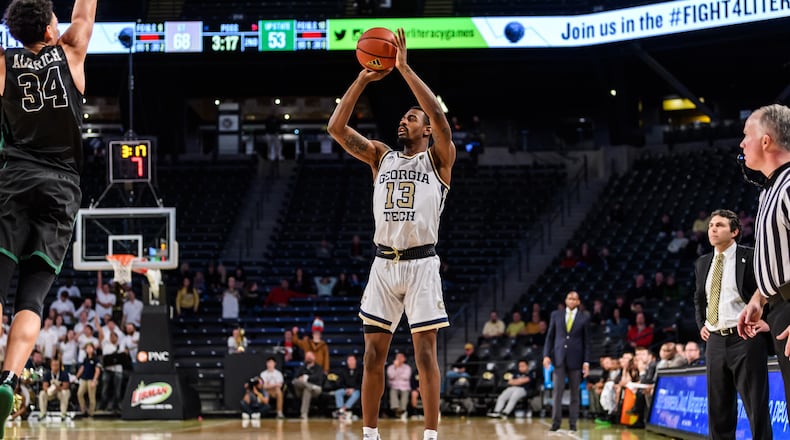The good news for Georgia Tech regarding its 3-point shooting is that the Yellow Jackets are exercising commendable discretion with their attempts.
Following Tech’s loss to No. 22 Florida State on Saturday, the coaching staff reviewed all 135 3-pointers taken in the first nine ACC games and cataloged more than 80 percent of them as open shots. As for the bad news? Anyone who follows the team knows that. The Jackets are missing at an alarming rate and, moreover, appear to be trending down.
Entering its Wednesday night home game against Clemson, Tech is shooting 29.1 percent from 3-point range for the season and 26.7 percent in ACC play. That’s good for 339th in Division I (out of 351 teams) and 14th in the ACC. Coach Josh Pastner described himself as bewildered after the Jackets held Florida State more than 18 points under its season scoring average but still lost 59-49, in no small part because they shot 3-for-21 from beyond the arc. Pastner said that he approved of 85 percent of the attempts in that game.
Some weren’t just open shots, but attempts “where you just have enough time where you can literally take your time,” Pastner said. “And I can’t tell ’em not to shoot because … you just can’t.”
As he spoke Monday with media, he sounded a bit like a man unsure of how to break his team’s slump, which has contributed to a three-game losing streak and dropped the Jackets to 11-11 overall and 3-6 in ACC play. As the Jackets continue to play elite defense, the failure to score, particularly from the perimeter, has become an overriding concern (along with turnovers).
“It’s not a lack of putting in the extra effort,” Pastner said. “We’re doing as much as we can on all the shooting. We’re shooting a lot in practice, after practice, making guys have to shoot (and) make a certain amount. And we’re getting great shots. It’d be easier if the shot selection was terrible. It’s great looks. It’s just they’re not going in.”
Pastner said he and his staff have considered giving playing time to freshman forward Kristian Sjolund, who has played a total of 58 minutes this season but has a good stroke and has been shooting well in practice. While Pastner has concerns about Sjolund’s ability to defend, Tech’s need for perimeter scoring is dire.
“That option is on the table,” Pastner said. “He’s got to stay ready.”
And, rather than more work, Pastner has felt that maybe less work could be the answer. Shooting the night before games at McCamish or at the opposing arena apparently hasn’t been the solution.
“Maybe the night before, we won’t do any shooting,” Pastner said. “We won’t come back and do anything. That’s our next phase.”
It already has impacted players’ frame of mind. Pastner has seen guard Jose Alvarado, who last season shot 37 percent from 3-point range but now is at 27.9 percent, pass up open 3-pointers. He was 0-for-5 on Saturday and was 0-for-10 overall in his first scoreless game of the season. Pastner has encouraged Alvarado to keep shooting.
Guard Michael Devoe is faring well, shooting 39.3 percent from 3 in ACC play. And Alvarado actually is shooting better in league play than he did in the non-conference schedule. But the highlights are few.
“It’s like there’s a little bit of a lid on the basket,” he said. “It’s due for the lid to be lifted.”
Getting the 3-point game going is critical not only because the Jackets rank last in the ACC in scoring. The more that the Jackets can draw defenses out, the more the interior will be open for post players James Banks and Abdoulaye Gueye. The latter has become the Jackets’ best scoring option, with 56 points on 49 shots in the past four games.
Tech isn’t alone in its struggles. Five teams in the ACC are shooting under 30 percent from 3 in league play. Since the 3-point arc was extended to 20 feet, 9 inches before the 2008-09 season, there has never been a season in which more than one team finished under 30 percent in ACC play.
Florida State coach Leonard Hamilton, whose team shot 22.9 percent from 3 in its first four ACC games, understands Pastner’s uncertainty.
“I wish I had an answer for that question, because I go out and I watch our kids do all our shooting drills, and we got ’em going full speed, we have four or five different baskets, we’re getting a high volume of shots, and I’m looking and saying, ‘Wow, we really can shoot the ball,’” Hamilton said.
The Seminoles have since improved, shooting 41 percent in the past eight games, despite being held to 4-for-16 shooting by Tech on Saturday. Hamilton recognized that his team didn’t suddenly become a better shooting team.
“That’s why I’m saying a lot of it is a maturity process, where kids have just got to play with a little more confidence,” Hamilton said.
About the Author
Keep Reading
The Latest
Featured



